Hongyi Zhu
Sequence of Expert: Boosting Imitation Planners for Autonomous Driving through Temporal Alternation
Dec 15, 2025Abstract:Imitation learning (IL) has emerged as a central paradigm in autonomous driving. While IL excels in matching expert behavior in open-loop settings by minimizing per-step prediction errors, its performance degrades unexpectedly in closed-loop due to the gradual accumulation of small, often imperceptible errors over time.Over successive planning cycles, these errors compound, potentially resulting in severe failures.Current research efforts predominantly rely on increasingly sophisticated network architectures or high-fidelity training datasets to enhance the robustness of IL planners against error accumulation, focusing on the state-level robustness at a single time point. However, autonomous driving is inherently a continuous-time process, and leveraging the temporal scale to enhance robustness may provide a new perspective for addressing this issue.To this end, we propose a method termed Sequence of Experts (SoE), a temporal alternation policy that enhances closed-loop performance without increasing model size or data requirements. Our experiments on large-scale autonomous driving benchmarks nuPlan demonstrate that SoE method consistently and significantly improves the performance of all the evaluated models, and achieves state-of-the-art performance.This module may provide a key and widely applicable support for improving the training efficiency of autonomous driving models.
MaCP: Minimal yet Mighty Adaptation via Hierarchical Cosine Projection
May 29, 2025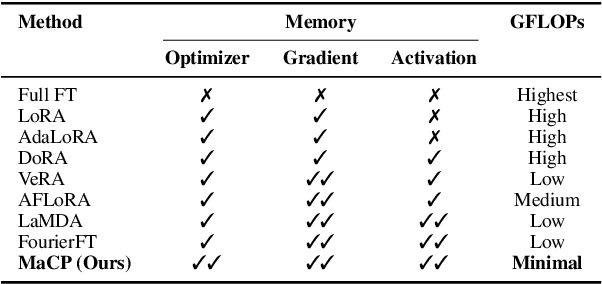
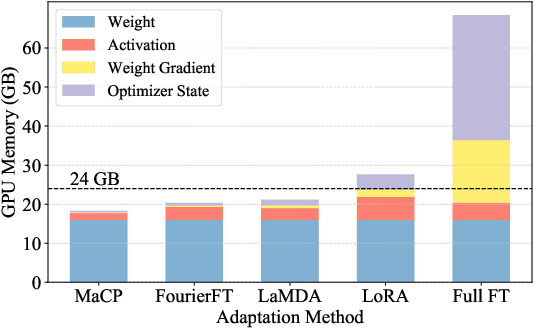
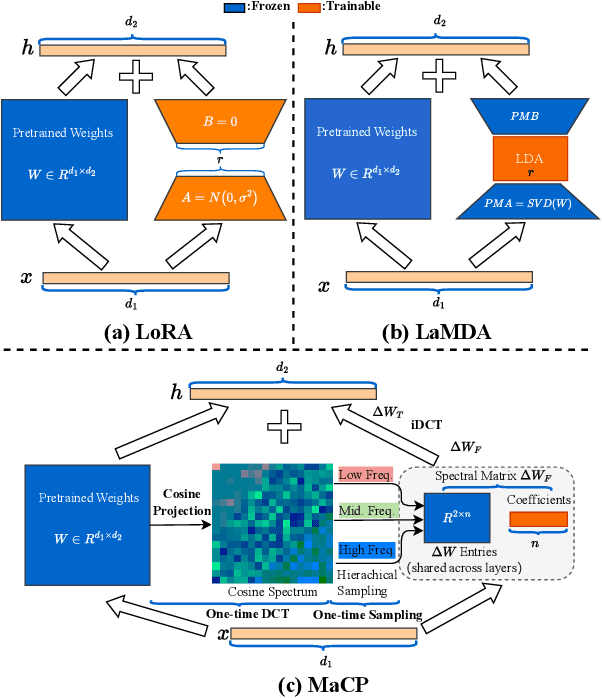
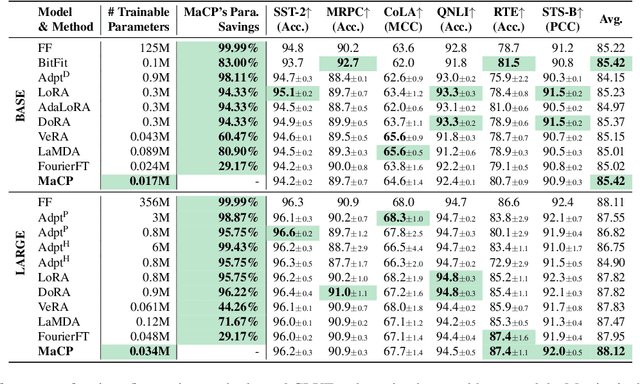
Abstract:We present a new adaptation method MaCP, Minimal yet Mighty adaptive Cosine Projection, that achieves exceptional performance while requiring minimal parameters and memory for fine-tuning large foundation models. Its general idea is to exploit the superior energy compaction and decorrelation properties of cosine projection to improve both model efficiency and accuracy. Specifically, it projects the weight change from the low-rank adaptation into the discrete cosine space. Then, the weight change is partitioned over different levels of the discrete cosine spectrum, and each partition's most critical frequency components are selected. Extensive experiments demonstrate the effectiveness of MaCP across a wide range of single-modality tasks, including natural language understanding, natural language generation, text summarization, as well as multi-modality tasks such as image classification and video understanding. MaCP consistently delivers superior accuracy, significantly reduced computational complexity, and lower memory requirements compared to existing alternatives.
ArtRAG: Retrieval-Augmented Generation with Structured Context for Visual Art Understanding
May 09, 2025Abstract:Understanding visual art requires reasoning across multiple perspectives -- cultural, historical, and stylistic -- beyond mere object recognition. While recent multimodal large language models (MLLMs) perform well on general image captioning, they often fail to capture the nuanced interpretations that fine art demands. We propose ArtRAG, a novel, training-free framework that combines structured knowledge with retrieval-augmented generation (RAG) for multi-perspective artwork explanation. ArtRAG automatically constructs an Art Context Knowledge Graph (ACKG) from domain-specific textual sources, organizing entities such as artists, movements, themes, and historical events into a rich, interpretable graph. At inference time, a multi-granular structured retriever selects semantically and topologically relevant subgraphs to guide generation. This enables MLLMs to produce contextually grounded, culturally informed art descriptions. Experiments on the SemArt and Artpedia datasets show that ArtRAG outperforms several heavily trained baselines. Human evaluations further confirm that ArtRAG generates coherent, insightful, and culturally enriched interpretations.
SSH: Sparse Spectrum Adaptation via Discrete Hartley Transformation
Feb 08, 2025



Abstract:Low-rank adaptation (LoRA) has been demonstrated effective in reducing the trainable parameter number when fine-tuning a large foundation model (LLM). However, it still encounters computational and memory challenges when scaling to larger models or addressing more complex task adaptation. In this work, we introduce Sparse Spectrum Adaptation via Discrete Hartley Transformation (SSH), a novel approach that significantly reduces the number of trainable parameters while enhancing model performance. It selects the most informative spectral components across all layers, under the guidance of the initial weights after a discrete Hartley transformation (DHT). The lightweight inverse DHT then projects the spectrum back into the spatial domain for updates. Extensive experiments across both single-modality tasks such as language understanding and generation and multi-modality tasks such as video-text understanding demonstrate that SSH outperforms existing parameter-efficient fine-tuning (PEFT) methods while achieving substantial reductions in computational cost and memory requirements.
Gradient Weight-normalized Low-rank Projection for Efficient LLM Training
Dec 27, 2024Abstract:Large Language Models (LLMs) have shown remarkable performance across various tasks, but the escalating demands on computational resources pose significant challenges, particularly in the extensive utilization of full fine-tuning for downstream tasks. To address this, parameter-efficient fine-tuning (PEFT) methods have been developed, but they often underperform compared to full fine-tuning and struggle with memory efficiency. In this work, we introduce Gradient Weight-Normalized Low-Rank Projection (GradNormLoRP), a novel approach that enhances both parameter and memory efficiency while maintaining comparable performance to full fine-tuning. GradNormLoRP normalizes the weight matrix to improve gradient conditioning, facilitating better convergence during optimization. Additionally, it applies low-rank approximations to the weight and gradient matrices, significantly reducing memory usage during training. Extensive experiments demonstrate that our 8-bit GradNormLoRP reduces optimizer memory usage by up to 89.5% and enables the pre-training of large LLMs, such as LLaMA 7B, on consumer-level GPUs like the NVIDIA RTX 4090, without additional inference costs. Moreover, GradNormLoRP outperforms existing low-rank methods in fine-tuning tasks. For instance, when fine-tuning the RoBERTa model on all GLUE tasks with a rank of 8, GradNormLoRP achieves an average score of 80.65, surpassing LoRA's score of 79.23. These results underscore GradNormLoRP as a promising alternative for efficient LLM pre-training and fine-tuning. Source code and Appendix: https://github.com/Jhhuangkay/Gradient-Weight-normalized-Low-rank-Projection-for-Efficient-LLM-Training
Image2Text2Image: A Novel Framework for Label-Free Evaluation of Image-to-Text Generation with Text-to-Image Diffusion Models
Nov 08, 2024



Abstract:Evaluating the quality of automatically generated image descriptions is a complex task that requires metrics capturing various dimensions, such as grammaticality, coverage, accuracy, and truthfulness. Although human evaluation provides valuable insights, its cost and time-consuming nature pose limitations. Existing automated metrics like BLEU, ROUGE, METEOR, and CIDEr attempt to fill this gap, but they often exhibit weak correlations with human judgment. To address this challenge, we propose a novel evaluation framework called Image2Text2Image, which leverages diffusion models, such as Stable Diffusion or DALL-E, for text-to-image generation. In the Image2Text2Image framework, an input image is first processed by a selected image captioning model, chosen for evaluation, to generate a textual description. Using this generated description, a diffusion model then creates a new image. By comparing features extracted from the original and generated images, we measure their similarity using a designated similarity metric. A high similarity score suggests that the model has produced a faithful textual description, while a low score highlights discrepancies, revealing potential weaknesses in the model's performance. Notably, our framework does not rely on human-annotated reference captions, making it a valuable tool for assessing image captioning models. Extensive experiments and human evaluations validate the efficacy of our proposed Image2Text2Image evaluation framework. The code and dataset will be published to support further research in the community.
Towards Trustworthy Web Attack Detection: An Uncertainty-Aware Ensemble Deep Kernel Learning Model
Oct 10, 2024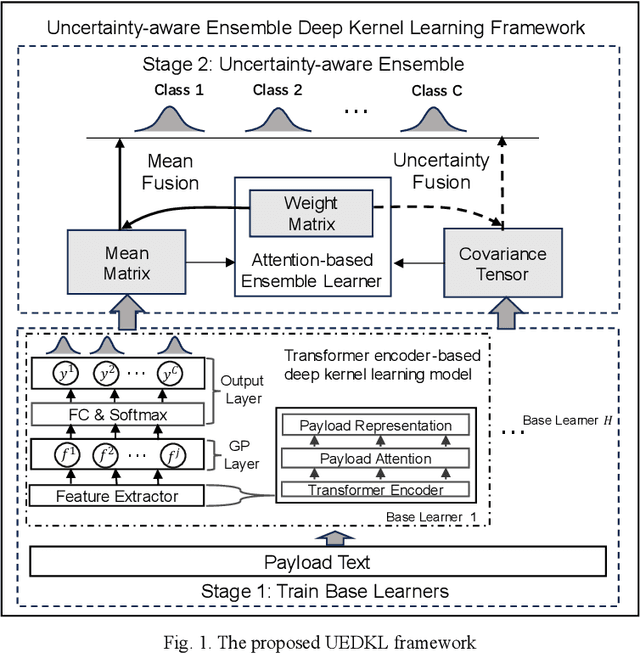

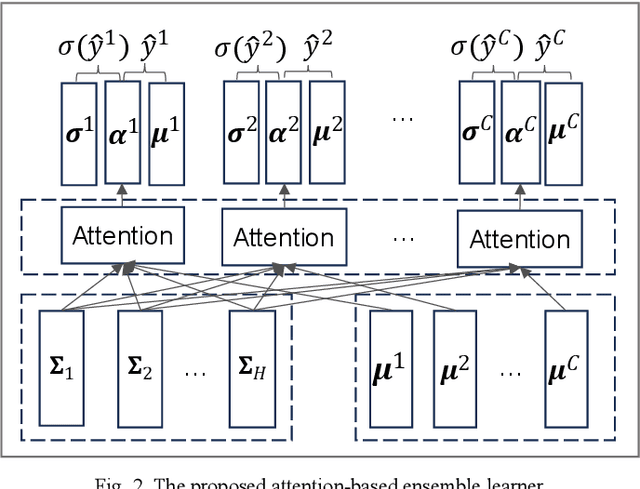
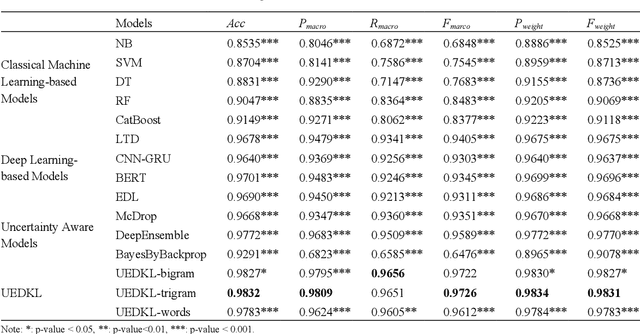
Abstract:Web attacks are one of the major and most persistent forms of cyber threats, which bring huge costs and losses to web application-based businesses. Various detection methods, such as signature-based, machine learning-based, and deep learning-based, have been proposed to identify web attacks. However, these methods either (1) heavily rely on accurate and complete rule design and feature engineering, which may not adapt to fast-evolving attacks, or (2) fail to estimate model uncertainty, which is essential to the trustworthiness of the prediction made by the model. In this study, we proposed an Uncertainty-aware Ensemble Deep Kernel Learning (UEDKL) model to detect web attacks from HTTP request payload data with the model uncertainty captured from the perspective of both data distribution and model parameters. The proposed UEDKL utilizes a deep kernel learning model to distinguish normal HTTP requests from different types of web attacks with model uncertainty estimated from data distribution perspective. Multiple deep kernel learning models were trained as base learners to capture the model uncertainty from model parameters perspective. An attention-based ensemble learning approach was designed to effectively integrate base learners' predictions and model uncertainty. We also proposed a new metric named High Uncertainty Ratio-F Score Curve to evaluate model uncertainty estimation. Experiments on BDCI and SRBH datasets demonstrated that the proposed UEDKL framework yields significant improvement in both web attack detection performance and uncertainty estimation quality compared to benchmark models.
Parameter-Efficient Fine-Tuning via Selective Discrete Cosine Transform
Oct 09, 2024Abstract:In the era of large language models, parameter-efficient fine-tuning (PEFT) has been extensively studied. However, these approaches usually rely on the space domain, which encounters storage challenges especially when handling extensive adaptations or larger models. The frequency domain, in contrast, is more effective in compressing trainable parameters while maintaining the expressive capability. In this paper, we propose a novel Selective Discrete Cosine Transformation (sDCTFT) fine-tuning scheme to push this frontier. Its general idea is to exploit the superior energy compaction and decorrelation properties of DCT to improve both model efficiency and accuracy. Specifically, it projects the weight change from the low-rank adaptation into the discrete cosine space. Then, the weight change is partitioned over different levels of the discrete cosine spectrum, and the most critical frequency components in each partition are selected. Extensive experiments on four benchmark datasets demonstrate the superior accuracy, reduced computational cost, and lower storage requirements of the proposed method over the prior arts. For instance, when performing instruction tuning on the LLaMA3.1-8B model, sDCTFT outperforms LoRA with just 0.05M trainable parameters compared to LoRA's 38.2M, and surpasses FourierFT with 30\% less trainable parameters. The source code will be publicly available.
A Novel Evaluation Framework for Image2Text Generation
Aug 03, 2024Abstract:Evaluating the quality of automatically generated image descriptions is challenging, requiring metrics that capture various aspects such as grammaticality, coverage, correctness, and truthfulness. While human evaluation offers valuable insights, its cost and time-consuming nature pose limitations. Existing automated metrics like BLEU, ROUGE, METEOR, and CIDEr aim to bridge this gap but often show weak correlations with human judgment. We address this challenge by introducing a novel evaluation framework rooted in a modern large language model (LLM), such as GPT-4 or Gemini, capable of image generation. In our proposed framework, we begin by feeding an input image into a designated image captioning model, chosen for evaluation, to generate a textual description. Using this description, an LLM then creates a new image. By extracting features from both the original and LLM-created images, we measure their similarity using a designated similarity metric. A high similarity score suggests that the image captioning model has accurately generated textual descriptions, while a low similarity score indicates discrepancies, revealing potential shortcomings in the model's performance. Human-annotated reference captions are not required in our proposed evaluation framework, which serves as a valuable tool for evaluating the effectiveness of image captioning models. Its efficacy is confirmed through human evaluation.
A Whole-Process Certifiably Robust Aggregation Method Against Backdoor Attacks in Federated Learning
Jun 30, 2024



Abstract:Federated Learning (FL) has garnered widespread adoption across various domains such as finance, healthcare, and cybersecurity. Nonetheless, FL remains under significant threat from backdoor attacks, wherein malicious actors insert triggers into trained models, enabling them to perform certain tasks while still meeting FL's primary objectives. In response, robust aggregation methods have been proposed, which can be divided into three types: ex-ante, ex-durante, and ex-post methods. Given the complementary nature of these methods, combining all three types is promising yet unexplored. Such a combination is non-trivial because it requires leveraging their advantages while overcoming their disadvantages. Our study proposes a novel whole-process certifiably robust aggregation (WPCRA) method for FL, which enhances robustness against backdoor attacks across three phases: ex-ante, ex-durante, and ex-post. Moreover, since the current geometric median estimation method fails to consider differences among clients, we propose a novel weighted geometric median estimation algorithm (WGME). This algorithm estimates the geometric median of model updates from clients based on each client's weight, further improving the robustness of WPCRA against backdoor attacks. We also theoretically prove that WPCRA offers improved certified robustness guarantees with a larger certified radius. We evaluate the advantages of our methods based on the task of loan status prediction. Comparison with baselines shows that our methods significantly improve FL's robustness against backdoor attacks. This study contributes to the literature with a novel WPCRA method and a novel WGME algorithm. Our code is available at https://github.com/brick-brick/WPCRAM.
 Add to Chrome
Add to Chrome Add to Firefox
Add to Firefox Add to Edge
Add to Edge